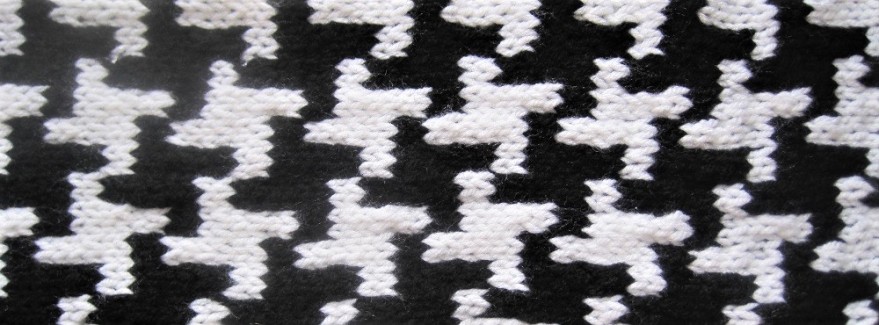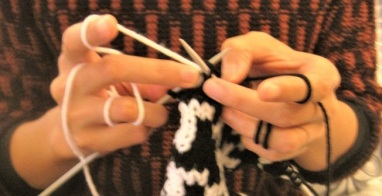I’ve been trying to get my stranded-knitting skills in swing.
A couple of weeks ago, I saw the Little Scallops hat pattern, and knew I had to try it. It’s a solid stranded-knitting starter. Just 5 rows of stranded colour work join the hat’s 2 colours – a veritable hands-tied-behind-your-back cakewalk for experienced stranded knitters, but a good introduction for newbies like me.

See those tiny bumps in the green scallop section? This is showing me that my tension is still a tad too tight, and is causing some puckering in the fabric. I need to work on loosening things up – stranded stitches need more room to ‘breathe’ than regular ones.
There are some relatively long (7-stitch) strands, or floats, in this pattern. I got to practice some float-catching, or weaving the longer strands back into the work…All in all, I’m happy with the hat and have been wearing it out on colder days.

For some reason, my first stranding project ever fared slightly better than this hat. It was an attempt, in Winter 2016, at knitting the houndstooth textile pattern. I think the more pucker-less appearance of this knit is due to some steam-blocking with the iron which relaxed the tenser stitches a bit.



On both practice runs above, I used a two-handed yarn-hold. It felt the most natural to me.
When I first taught myself to knit at 16, I ‘threw’ the yarn from my right hand – ‘throwing’ was the bold gesture I liked. It was what knitting was all about! When I re-started knitting in 2016, I learned Continental left-handed knitting. It felt a little faster to me, and I also liked engaging my usually dormant left-hand a bit more in my daily life. It’s been a bit of a circuitous path where yarn-holds are concerned, but this indecision turned out to be very good for easing into stranded colour work: I had a new-found left-handed ease, and re-learning a right-handed ‘throw’ brought back memories of those very first, very earnest, adolescent acrylic knits. 🙂

That’s all on the stranded-knitting front for now. I’m keeping my eye on the prize: an Icelandic lopapeysa-inspired pullover.
Ok, time for more practice!


How wonderful that you’re doing colorwork! I really enjoy stranded knitting. It’s got a rhythm all its own that is almost hypnotic, and the results are so pleasing!! 🙂
LikeLiked by 1 person
You put it beautifully. 🙂 I couldn’t agree more!
LikeLike
Stranded colorwork is kind of addictive, especially when you get the hang of holding yarn in both hands. Love the scallops.
LikeLiked by 1 person
I really enjoy the scallops, too. I’m loving the two-handed hold; I tried (and tried) the other ones, and I got so tangled. I find this hold a good way to stay a little more tangle free. 🙂
LikeLiked by 1 person
I just wondered if you did your projects on straight needles or circular. Perhaps easier to keep the strands slacker on straights?
LikeLiked by 1 person
Wow, I didn’t think of that – I will look into it! The hat was done on circular, the houndstooth thing on straights. Thank you, Tina.
LikeLike
I have never used circulars with stranded but a friend was chatting about just that a couple of weeks ago and said it’s a real fiddle to see inside when it’s on a circular. I guess either style just gets a lot better with practice!
LikeLiked by 1 person
Ah, yes, I can see how that would be. I’ve also heard that there are tension-changes introduced for not having to do the purls on the circular, so I suspect that also throws a wrench into things! Ultimately, yes, practice is it. Stranded knits are so hard won (but fun). 🙂
LikeLike
You are so talented. I am blown away!
LikeLiked by 1 person
Aw, you’re too kind. Thanks for reading. 🙂
LikeLiked by 1 person
Wooooah, two-handed colourwork! I tried to teach myself to do continental-style knitting a few years back, and couldn’t get into the swing of it at all… Turns out I’m really, really right-handed! 😆 If you’re having problems with tension when you do colourwork in the round, I’ve heard that turning the piece inside out helps – having the floats on the outside of the tube while you knit means they each have to be a little longer, so the fabric is more relaxed when you turn it back the right way. Your finished hat looks super though – I love that scalloped pattern!
LikeLike
I’ve found all the different yarn-hold options so interesting – more proof that knitting is an art that allows us to cultivate our particularities. I love that about it. I will try turning the piece inside out next time I hazard some colourwork in the round! I can see how it would help to loosen those floats just a little more. Thank you for this great tip, Helen. 🙂
LikeLiked by 1 person
No problemo! Let me know how it goes… I think I used that technique myself before, but it was ages ago and I can’t remember if it made a difference or not! Happy knitting 😀
LikeLiked by 1 person
you go, Shirley! Loving the results of your handiwork!
LikeLiked by 1 person
🙂 Thank you, Melissa!
LikeLike
Sorry I missed your post – technology issues! Both of these pieces of knitting look fabulous. I only found out about Continental knitting from another blogger and it looks fascinating. Kind of makes more sense, in a way. Must have been tough to ‘re-learn a skill though!
LikeLiked by 1 person
Thank you, Gillian. 🙂 I will always have a spot in my heart for ‘throwing.’ Hoping you’re enjoying some knitting these days, too. 🙂
LikeLiked by 1 person
Your houndstooth pattern looks amazing! So incredibly neat 😀 Im getting inspired to try some colour work ❤
LikeLiked by 1 person
Thank you. Go for it! Your colour work will be great! 🙂
LikeLike
Wow! This is awesome. Love the work that you create here. ❤ I had no idea of the different skills involved with knitting. Fun to read. ~Debbie
LikeLiked by 1 person
Thanks for reading, Debbie. Wishing you a beautiful weekend. 🙂
LikeLiked by 1 person
It was wonderful! Hope yours was great as well. Many blessings ~Debbie 🙂
LikeLiked by 1 person
Stranded color knitting is one of my weaker knitting skills, but I feel like every time I knit up a project using this technique I get better at it. If I don’t do any for a long time I tend to forget how my hands should work and my first few rounds often feel awkward and then I can zip along pretty well. I hope you continue working on your skills and start feeling more and more comfortable with it. For me it was not at all easy to learn this Hats were a good way for me to learn.
LikeLiked by 1 person
Thanks, Tony. Stranded knitting is definitely not my forte, but I love colour work when I see it. Wonderful to hear that progress comes with each new project. That’s very encouraging to hear about such a hard won skill!
LikeLiked by 1 person